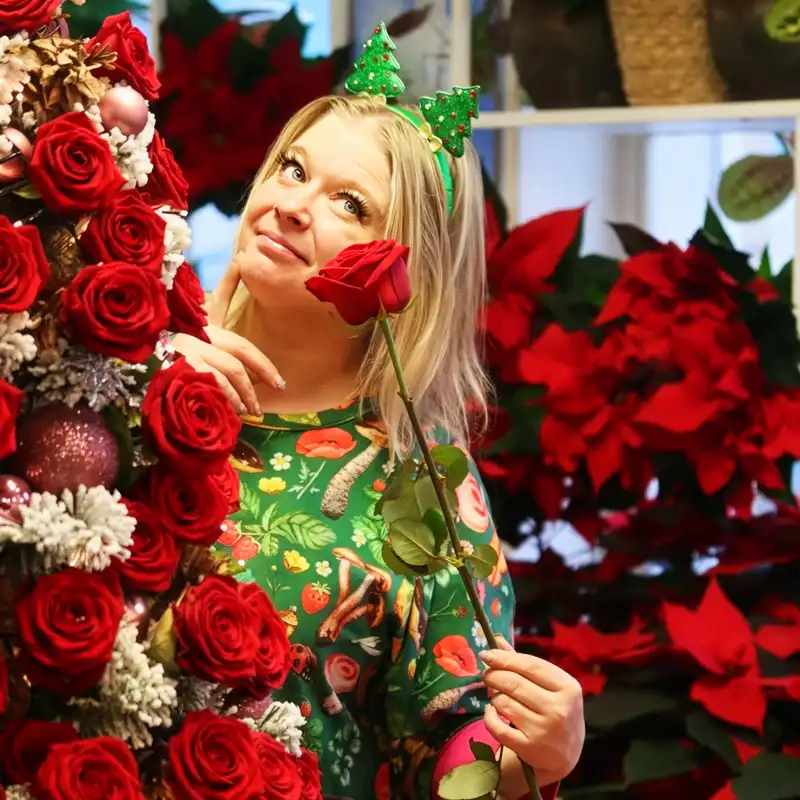Rose Born Free is a groundbreaking new red rose variety that offers a fresh opportunity for growers, distributors, and floral designers alike.
"The main advantage of Born Free is that it's highly productive, and besides being a great looking, flat-ruffled, romantic red rose, is that Born Free is absolutely thornless."
The U.S. Markets Are Ready for New Red Rose Varieties
To summarize the impact of the red rose variety Born Free® on the U.S. market, it represents an outstanding addition to the red rose category, catering to large-scale production and diverse use cases across the mass market and wholesale sectors.

Currently, the market is dominated mainly by the longstanding Rose Freedom variety. However, U.S. importers, distributors, wholesalers, supermarkets, and floral designers have expressed enthusiasm for introducing new red rose varieties to expand and enrich their offerings. These innovations, featuring new shades of red and distinctive shapes, are not intended to replace established favorites like Rose Freedom per se. Instead, they complement the existing selection, offering greater variety and appeal to meet customers' evolving demands.

Born Free Roses Are Welcomed in the Markets
Because the Born Free rose adds a new shape, shade, and thorn-freeness to the markets, it is very well-received by distributors, wholesalers, and designers.
- The Shape of the Red Rose Born Free
- The Born Free’s aesthetic appeal lies in its unique ruffled, flat shape, which opens up nicely to create a romantic visual impact.
- The Red Rose Born Free's Color Shade
- Born Free has a classic red rose color with deep crimson velvet petals. When opening, it shows its petals with an impressive never-to-be-forgotten brightness. It's easy to reflex or fold open.
- The Red Rose Born Free is Thornless
- Born Free is a game-changer for florists and designers who value ease of handling and safety while enhancing the overall experience for all involved.
See more about the benefits of being Thornless in the FAQ below.

The U.S. Red Rose Market Has a Conservative Nature
The U.S. floral market has traditionally been known for its conservative nature, adhering to the principle of "why change something that already works?" This mindset has historically prioritized tried-and-true varieties and familiar standards, ensuring reliability and consistency for growers, distributors, and consumers alike.
However, this perspective has seen a noticeable shift in recent years. Many industry experts and stakeholders now recognize that the market is becoming increasingly receptive to innovation and variety. Changing consumer preferences, driven by a desire for unique and eye-catching options and a growing appreciation for sustainability and efficiency, have created a fertile ground for introducing new products. As a result, the U.S. market is more open than ever to embracing fresh ideas and experimenting with alternatives that promise to enhance aesthetics and practicality.
Through firsthand insights gathered during visits to six farms in Ecuador and discussions with key players in Miami’s floral market, it is clear that its unique qualities of being thornless, highly productive, and beautifully flat and ruffled, the potential of the Born Free variety is large. This is a reel by Shallima Turizo Dancur of the EQR farm Visit:
Born Free’s Unique Qualities for Growers
With yields twice that of leading red rose varieties and being a healthy plant, Born Free offers significant advantages for growers, from reduced land use to increased profitability. Besides the high productivity, Born Free is not susceptible to blackening and needs no specific netting or plastic, a considerable advantage and cost-saving attribute. Also, harvesting is more efficient because more stems are cut per m/2, and post-harvest, thornlessness is attributed to easier handling. The packing rate of Born Free is also excellent.

Born Free’s Pinching Qualities
Born Free is an ideal rose variety for pinching, making it an excellent choice for growers looking to optimize production schedules. Its strong growth habits allow it to respond exceptionally well to pinching, with robust lateral shoots and consistent regeneration after each pinch. This makes it easier for growers to align peak production with major floral holidays like Valentine’s Day and Mother’s Day, ensuring a steady supply of high-quality roses. Additionally, Born Free quickly rebounds after pinching, maintaining excellent stem strength, bloom size, and plant vigor. These qualities make it a reliable and productive choice for meeting market demands with precision and efficiency.
See more about the pinching roses in the FAQ below.
Advantages for Growers
- Increased Productivity: Doubling the output compared to traditional varieties allows growers to maximize their resources.
- Reduced Labor Costs: There's no need for additional labor against blackening. The thornless nature simplifies harvesting and handling, reducing the time and effort required by workers.
- Sustainability: The plants are very healthy and are low on pesticide use. Higher yields on the same acreage contribute to a more sustainable approach to rose farming, minimizing environmental impact.
- Planning and scheduling: Born Free is easy to pinch to double down on productivity during the important flower holidays.

Opportunities of Born Free for U.S. Distributors and Wholesalers
Born Free offers U.S. distributors and wholesalers a remarkable opportunity to diversify red rose offerings with a product that combines aesthetic charm and practical advantages. Its striking flat, ruffled blooms and vibrant red hue make it an eye-catching choice for customers, while its thornless stems address operational challenges.
Thornlessness significantly reduces handling time, minimizes labor-intensive cleaning processes, and ensures seamless packing and transportation with minimal risk of damage. These features improve efficiency and reduce costs across the supply chain. Furthermore, Born Free's romantic appeal and unique design offer wholesalers an exceptional product to attract floral designers and retailers looking for something new. As the floral market increasingly values innovation and convenience, Born Free is a versatile solution that enhances workflow and customer satisfaction. This rose is not just a new variety but a strategic addition to elevate business performance.
Advantages for Distributors and Wholesalers
- Market Differentiation: The variety’s distinctive appearance and thornless stems provide a competitive edge in a crowded red rose market.
- Higher Profit Margins: The increased productivity at the source translates into cost-effective pricing and greater flexibility in meeting market demands.
- Consumer Appeal: Retailers report strong initial interest due to the rose’s striking blooms and practical advantages.

Born Free Is a Designer’s Delight
Born Free is a designer's delight because it combines beauty, practicality, and versatility, making it ideal for both intricate arrangements and large-scale designs. Its thornless stems provide a safe and hassle-free handling experience, saving time and effort during preparation and assembly.
The flat, ruffled petals and vibrant red hue offer a unique and romantic aesthetic in bouquets, centerpieces, and event decorations. Born Free’s blooms open while maintaining their structure, creating an eye-catching, fresh, impactful display. This versatility allows designers to unleash their creativity without compromising convenience, making Born Free a go-to choice for weddings, events, and everyday arrangements.

Advantages for Designers
- Ease of Handling: The thornless stems make designing safer and quicker, particularly for large-scale events or intricate arrangements.
- Versatile Aesthetics: The flat, ruffled petals and vibrant red color offer endless possibilities for bouquets, centerpieces, and installations.
- Long-Lasting Appeal: Its ability to open fully yet maintain structure ensures a lasting impression in both personal and commercial settings.
About the Variety Born Free®
The Born Free variety stands out for its impressive productivity, delivering 1.6 to 1.8 flowers per plant per month. Its vibrant bright red color shows no signs of blackening, paired with an average head size of 6 cm and stem lengths ranging from 60 to 70 cm, making it highly appealing in the market. The production area in Ecuador spans approximately 10 hectares and is rapidly expanding due to growing demand. The variety boasts excellent vase life, lasting at least 12 days, and performs exceptionally well during transport, including sea freight, ensuring freshness and quality upon arrival.
Born Free is more than a red rose—it is almost a revolution in floral innovation. From growers in Ecuador to designers in the U.S., its advantages resonate across the supply chain. As the variety gains traction in farms and markets, it’s clear that Born Free is set to become a cornerstone of the floral industry, delivering beauty and practicality in equal measure. Stay tuned for updates on this promising variety as it continues to flower—literally and figuratively—in the U.S. market.
Are you ready to embrace the Born Free revolution? Join us as we continue to explore its impact on the floral industry, and consider making it part of your next bouquet or arrangement.











